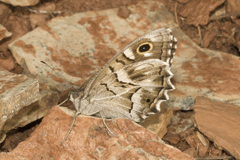| Hipparchia fidia | |
|---|---|
 | |
| Scientific classification | |
| Kingdom: | Animalia |
| Phylum: | Arthropoda |
| Class: | Insecta |
| Order: | Lepidoptera |
| Family: | Nymphalidae |
| Genus: | Hipparchia |
| Species: | H. fidia |
| Binomial name | |
| Hipparchia fidia | |
| Synonyms | |
| |
Hipparchia fidia, the striped grayling, is a butterfly of the family Nymphalidae. [1] It is found on the Iberian Peninsula, the Balearic Islands and in south-eastern France and the bordering parts of Italy and North Africa.



